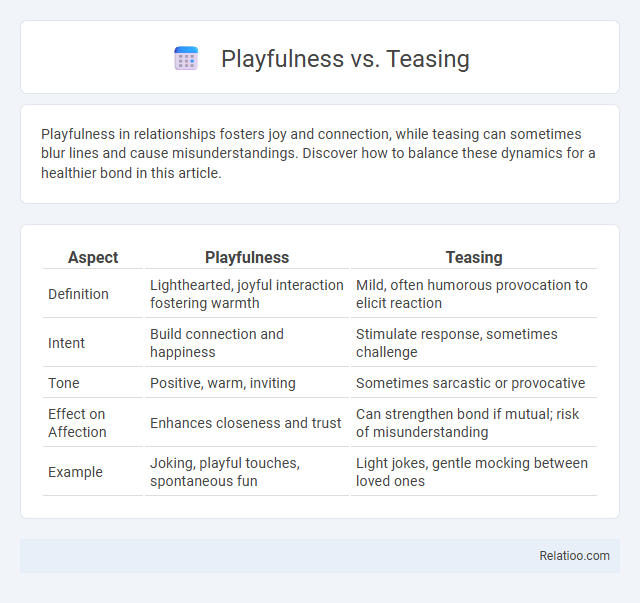Playfulness in relationships fosters joy and connection, while teasing can sometimes blur lines and cause misunderstandings. Discover how to balance these dynamics for a healthier bond in this article.
Table of Comparison
| Aspect | Playfulness | Teasing |
|---|---|---|
| Definition | Lighthearted, joyful interaction fostering warmth | Mild, often humorous provocation to elicit reaction |
| Intent | Build connection and happiness | Stimulate response, sometimes challenge |
| Tone | Positive, warm, inviting | Sometimes sarcastic or provocative |
| Effect on Affection | Enhances closeness and trust | Can strengthen bond if mutual; risk of misunderstanding |
| Example | Joking, playful touches, spontaneous fun | Light jokes, gentle mocking between loved ones |
Understanding Playfulness: Definition and Context
Playfulness involves engaging in spontaneous, joyful interactions that foster creativity and connection, differing from teasing which often includes humor with slight provocation, and playfulness emphasizing lightheartedness without intent to challenge. Understanding playfulness requires recognizing it as a broad behavioral style adaptable to social contexts, promoting positive emotions and bonding without causing discomfort. Your ability to distinguish these nuances can enhance communication and build stronger relationships through tailored playful interactions.
What Constitutes Teasing?
Teasing constitutes playful behavior that includes lighthearted jokes or remarks intended to amuse rather than hurt, often involving gentle provocation or mock criticism. Unlike general playfulness, teasing is characterized by a subtle balance between humor and challenge, where the intent is to engage and connect rather than offend. Your ability to recognize the fine line between teasing and harmful teasing ensures healthy, enjoyable interactions.
Key Differences Between Playfulness and Teasing
Playfulness involves lighthearted and spontaneous behaviors that foster joy and positive social interactions, while teasing often includes joking or mild taunts that can be misunderstood or hurtful depending on context. The key difference lies in intent and perception; playfulness aims to create fun without harm, whereas teasing may border on discomfort or exclusion if persistent or insensitive. Understanding these distinctions helps you communicate clearly and maintain healthy, enjoyable interactions.
Psychological Impact on Relationships
Playfulness fosters positive emotional bonds by encouraging creativity and mutual enjoyment, whereas teasing can create ambiguity that either strengthens intimacy through shared humor or causes hurt if misinterpreted. Your ability to discern the intent behind teasing affects trust and emotional safety in relationships, impacting long-term connection. Balancing playful interactions with respectful boundaries enhances psychological well-being and relational satisfaction.
Cultural Perspectives on Playfulness and Teasing
Cultural perspectives on playfulness and teasing vary significantly, influencing social interactions and communication styles worldwide. In collectivist cultures such as Japan and India, teasing is often subtle and indirect, emphasizing group harmony, while Western societies like the United States and Australia generally embrace more direct, playful teasing as a form of bonding. Understanding these cultural nuances is crucial for interpreting behavior accurately and fostering respectful cross-cultural relationships.
When Playfulness Crosses the Line
Playfulness fosters positive social bonds through lighthearted interactions, while teasing involves gentle provocation that can either amuse or annoy depending on context and intent. When playfulness crosses the line into teasing, it risks causing discomfort, misunderstanding, or emotional harm if perceived as mocking or intrusive. Recognizing cues such as body language and verbal responses helps maintain a healthy balance between playful behavior and respectful communication.
The Role of Intent: Fun or Harm?
Playfulness centers on shared enjoyment and positive social bonding, whereas teasing often involves ambiguous intent that can range from humorous to hurtful depending on context and delivery. The role of intent is crucial in distinguishing these behaviors; playfulness aims to foster connection and fun, while teasing can unintentionally or deliberately cause discomfort or harm. Your ability to interpret and respond to these cues impacts the quality of social interactions and emotional wellbeing.
Navigating Boundaries: Communication and Consent
Navigating boundaries between playfulness, teasing, and playfulness requires clear communication and explicit consent to ensure all parties feel respected and comfortable. Establishing mutual understanding helps prevent misunderstandings and fosters a safe space where your intentions are interpreted accurately. Recognizing verbal and nonverbal cues is essential for adjusting behavior and maintaining positive interactions without crossing personal limits.
Healthy Playfulness: Building Connection
Healthy playfulness fosters genuine connection by encouraging mutual respect and shared joy without crossing boundaries. Playfulness differs from teasing by emphasizing positive interactions that uplift rather than provoke, ensuring your relationships thrive on trust and laughter. Engaging in playful behavior enhances emotional bonds and promotes open communication, creating a safe space for authentic connection.
Recognizing and Addressing Harmful Teasing
Playfulness fosters positive social interactions by encouraging fun and light-heartedness, while teasing can sometimes cross boundaries, leading to hurtful or harmful experiences. Recognizing harmful teasing involves identifying patterns of exclusion, ridicule, or persistent negative comments that impact emotional well-being, especially in settings like schools or workplaces. Addressing harmful teasing requires clear communication, setting boundaries, and promoting empathy to create a respectful and supportive environment.

Infographic: Playfulness vs Teasing
 relatioo.com
relatioo.com